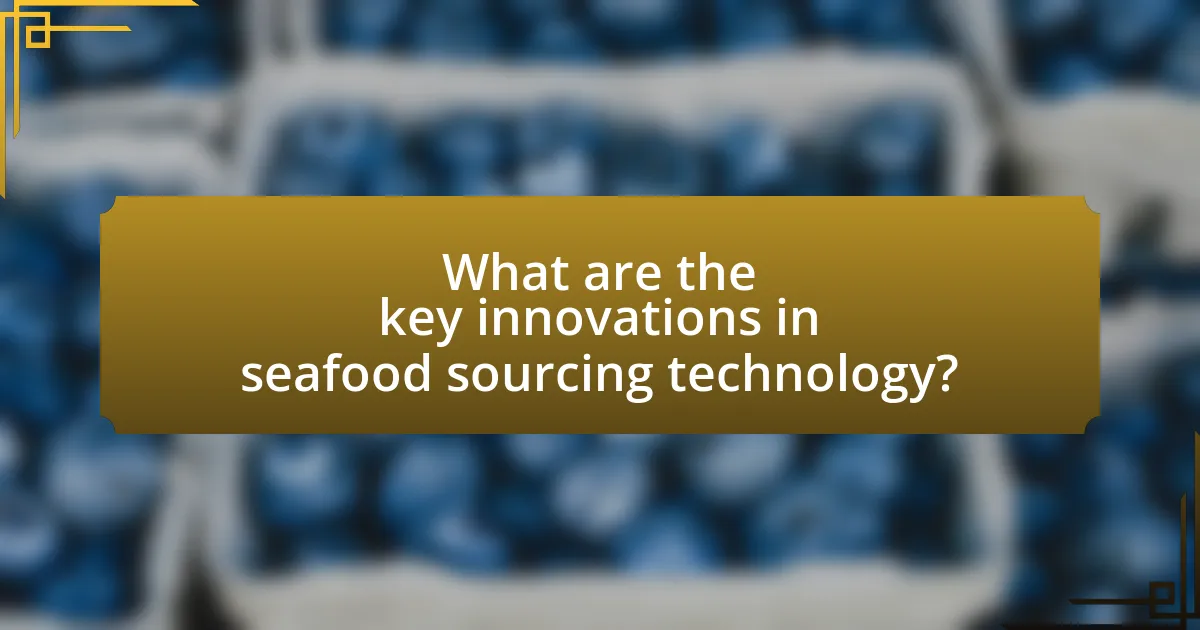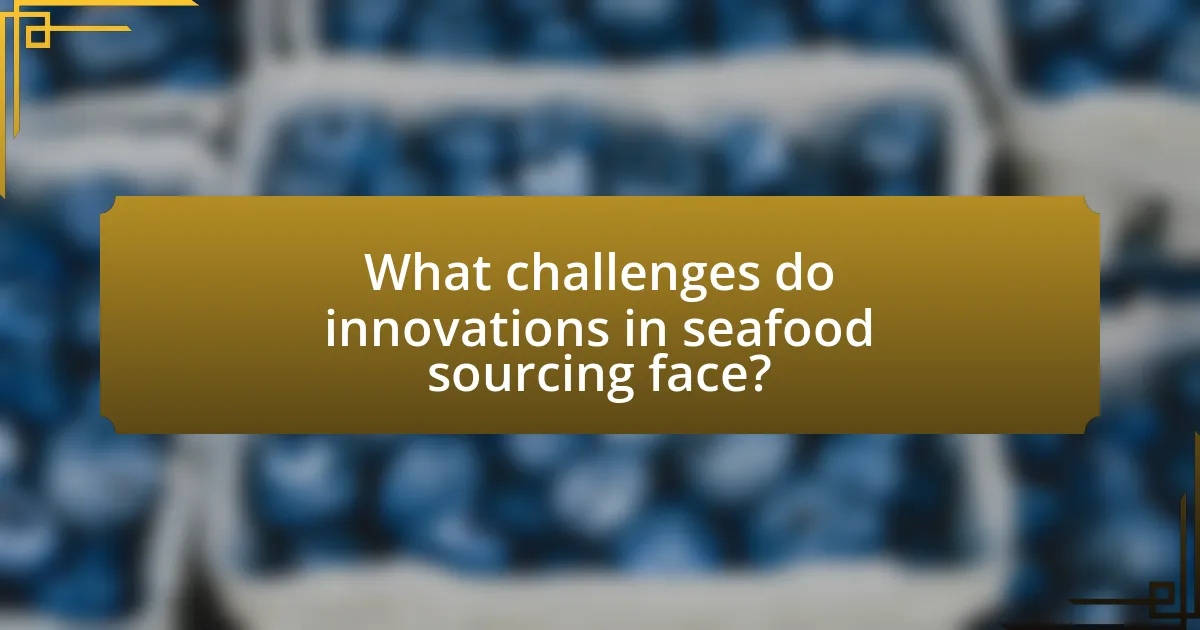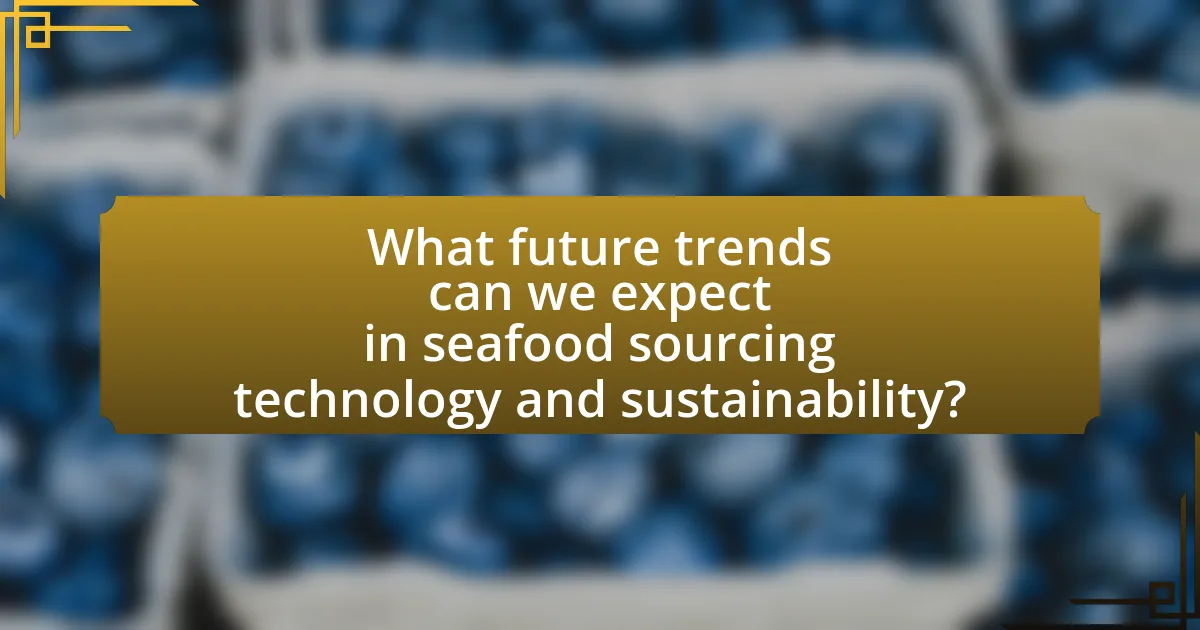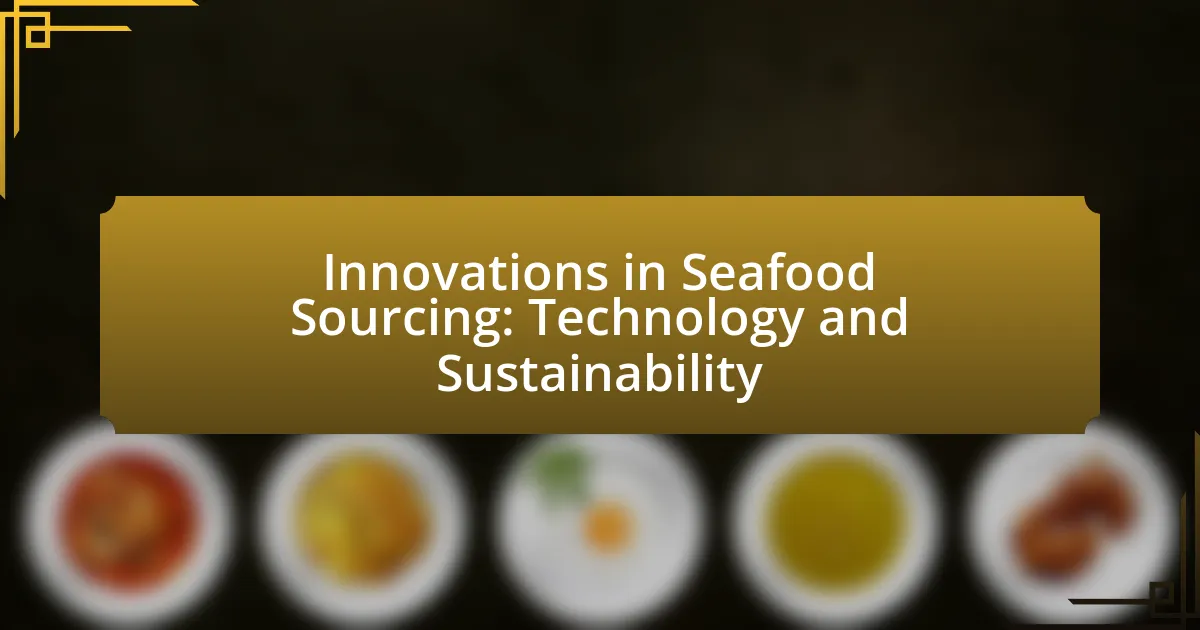The article focuses on innovations in seafood sourcing, emphasizing the role of technology and sustainability in transforming the industry. Key advancements include the use of blockchain for traceability, artificial intelligence for supply chain optimization, and sustainable aquaculture practices. These technologies enhance transparency, improve efficiency, and promote responsible fishing methods, addressing challenges such as overfishing and environmental impact. The article also explores the implications of real-time data, consumer preferences, and regulatory frameworks on seafood sourcing practices, highlighting the importance of collaboration and best practices for achieving sustainability in the seafood industry.

What are the key innovations in seafood sourcing technology?
Key innovations in seafood sourcing technology include blockchain for traceability, artificial intelligence for supply chain optimization, and aquaculture advancements for sustainable farming. Blockchain technology enhances transparency by allowing consumers to track the origin of seafood, ensuring authenticity and reducing fraud. Artificial intelligence algorithms analyze data to optimize inventory management and predict demand, leading to reduced waste and improved efficiency. Additionally, advancements in aquaculture, such as recirculating aquaculture systems, enable sustainable fish farming practices that minimize environmental impact while meeting growing seafood demand. These innovations collectively contribute to a more sustainable and efficient seafood sourcing industry.
How has technology transformed seafood sourcing practices?
Technology has transformed seafood sourcing practices by enhancing traceability, improving supply chain efficiency, and promoting sustainable fishing methods. Advanced technologies such as blockchain enable real-time tracking of seafood from catch to consumer, ensuring transparency and authenticity. For instance, a study by the World Wildlife Fund highlights that blockchain can reduce illegal fishing by up to 30% by providing verifiable data on the origin of seafood. Additionally, the use of satellite technology and drones allows for better monitoring of fishing activities, helping to prevent overfishing and protect marine ecosystems. These innovations not only improve the quality and safety of seafood but also support sustainable practices that are crucial for the long-term health of ocean resources.
What specific technologies are being utilized in seafood sourcing?
Specific technologies utilized in seafood sourcing include blockchain, satellite tracking, and artificial intelligence. Blockchain technology enhances traceability and transparency in the supply chain, allowing consumers to verify the origin of seafood products. Satellite tracking systems monitor fishing vessels in real-time, ensuring compliance with regulations and sustainable practices. Artificial intelligence is employed for data analysis, predicting fish populations, and optimizing supply chain logistics. These technologies collectively contribute to more sustainable and responsible seafood sourcing practices.
How do these technologies improve efficiency in sourcing seafood?
Technologies improve efficiency in sourcing seafood by enhancing traceability, optimizing supply chains, and reducing waste. Advanced tracking systems, such as blockchain, allow for real-time monitoring of seafood from catch to consumer, ensuring transparency and reducing fraud. Additionally, data analytics and machine learning streamline inventory management and demand forecasting, leading to better resource allocation and minimized overfishing. For instance, a study by the Food and Agriculture Organization reported that implementing technology in fisheries can increase operational efficiency by up to 30%, demonstrating the tangible benefits of these innovations in the seafood industry.
What role does data play in modern seafood sourcing?
Data plays a crucial role in modern seafood sourcing by enhancing traceability, sustainability, and efficiency in the supply chain. Advanced data analytics allows stakeholders to monitor fish populations, track sourcing locations, and ensure compliance with sustainability standards. For instance, the Global Fishing Watch initiative utilizes satellite data to monitor fishing activities in real-time, helping to combat illegal fishing and promote responsible sourcing practices. Additionally, data-driven platforms enable consumers to access information about the origin and environmental impact of seafood products, fostering informed purchasing decisions. This integration of data not only supports sustainable practices but also strengthens the overall integrity of the seafood supply chain.
How is data analytics used to enhance seafood sourcing decisions?
Data analytics enhances seafood sourcing decisions by providing insights into supply chain dynamics, market trends, and sustainability practices. By analyzing data from various sources, such as catch reports, consumer preferences, and environmental impact assessments, seafood companies can make informed decisions that optimize sourcing strategies. For instance, a study by the Food and Agriculture Organization (FAO) indicates that data analytics can improve traceability in seafood supply chains, ensuring that sourcing aligns with sustainability standards and reduces illegal fishing practices. This data-driven approach not only increases operational efficiency but also supports responsible sourcing, ultimately benefiting both businesses and marine ecosystems.
What are the implications of real-time data in seafood sourcing?
Real-time data in seafood sourcing enhances traceability, sustainability, and efficiency in the supply chain. By providing immediate insights into fish stock levels, environmental conditions, and market demand, stakeholders can make informed decisions that promote responsible sourcing practices. For instance, the Global Fishing Watch initiative utilizes satellite data to monitor fishing activities, helping to combat illegal fishing and overfishing. This real-time monitoring leads to better management of marine resources, ensuring that seafood is sourced sustainably and responsibly. Additionally, real-time data allows for dynamic pricing strategies, optimizing profit margins while reducing waste, as suppliers can adjust their offerings based on current market conditions.
How do innovations in seafood sourcing impact sustainability?
Innovations in seafood sourcing significantly enhance sustainability by promoting responsible fishing practices and reducing overfishing. Technologies such as blockchain improve traceability, ensuring that seafood is sourced from sustainable fisheries, which helps protect marine ecosystems. For instance, the Global Fishing Watch initiative utilizes satellite technology to monitor fishing activities in real-time, allowing for better enforcement of regulations and reducing illegal fishing. Additionally, advancements in aquaculture, such as integrated multi-trophic aquaculture, optimize resource use and minimize environmental impact, contributing to sustainable seafood production. These innovations collectively support the long-term health of ocean resources and ecosystems.
What sustainable practices are being adopted in seafood sourcing?
Sustainable practices in seafood sourcing include the implementation of traceability systems, responsible fishing methods, and aquaculture advancements. Traceability systems allow consumers to track the origin of seafood, ensuring it comes from sustainable sources, as evidenced by the Global Sustainable Seafood Initiative, which promotes transparency in the supply chain. Responsible fishing methods, such as using selective gear and adhering to catch limits, help prevent overfishing and protect marine ecosystems, supported by regulations from organizations like the Marine Stewardship Council. Additionally, advancements in aquaculture, including integrated multi-trophic aquaculture, enhance sustainability by reducing environmental impacts and improving resource efficiency, as highlighted in research by the Food and Agriculture Organization.
How do these practices contribute to environmental conservation?
Innovations in seafood sourcing contribute to environmental conservation by promoting sustainable fishing practices that reduce overfishing and protect marine ecosystems. For instance, technologies such as satellite tracking and data analytics enable fisheries to monitor fish populations and avoid catching endangered species, thereby maintaining biodiversity. Additionally, practices like aquaculture, when managed responsibly, can alleviate pressure on wild fish stocks and minimize habitat destruction. According to the Food and Agriculture Organization, sustainable fisheries management can lead to a 20% increase in fish stocks, which supports both ecological balance and the livelihoods of fishing communities.

What challenges do innovations in seafood sourcing face?
Innovations in seafood sourcing face challenges such as regulatory compliance, sustainability concerns, and supply chain complexities. Regulatory compliance is often difficult due to varying international laws and standards that govern seafood sourcing, which can hinder innovation. Sustainability concerns arise from the need to balance economic viability with environmental impact, as overfishing and habitat destruction threaten marine ecosystems. Additionally, supply chain complexities, including traceability and logistics, complicate the implementation of new technologies and practices, making it harder to ensure that seafood is sourced responsibly and efficiently. These challenges are supported by studies indicating that 90% of global fish stocks are overfished or fully exploited, highlighting the urgent need for sustainable sourcing innovations.
What are the barriers to adopting new technologies in seafood sourcing?
The barriers to adopting new technologies in seafood sourcing include high initial costs, lack of technical expertise, regulatory challenges, and resistance to change within the industry. High initial costs can deter companies from investing in advanced technologies, as they may require significant capital for implementation. The lack of technical expertise limits the ability of seafood businesses to effectively utilize new technologies, leading to underperformance or failure. Regulatory challenges arise from the need to comply with existing laws and standards, which can slow down the adoption process. Additionally, resistance to change is prevalent in traditional sectors like seafood sourcing, where established practices are deeply ingrained, making stakeholders hesitant to embrace innovative solutions. These barriers collectively hinder the progress towards more sustainable and efficient seafood sourcing practices.
How do regulatory frameworks affect seafood sourcing innovations?
Regulatory frameworks significantly influence seafood sourcing innovations by establishing guidelines that promote sustainable practices and technological advancements. These frameworks often mandate compliance with environmental standards, which incentivizes companies to adopt innovative sourcing methods, such as traceability technologies and eco-labeling. For instance, the European Union’s Common Fisheries Policy enforces quotas and sustainable fishing practices, pushing the industry towards more responsible sourcing innovations. Additionally, regulations can drive investment in research and development, as companies seek to meet compliance requirements while improving efficiency and sustainability in their sourcing processes.
What are the economic challenges associated with implementing new technologies?
The economic challenges associated with implementing new technologies include high initial investment costs, potential job displacement, and the need for ongoing maintenance and training. High initial investment costs can deter businesses from adopting new technologies, as they may require significant capital outlay for equipment and infrastructure. For instance, the seafood industry may face costs related to advanced tracking systems or sustainable sourcing technologies. Additionally, potential job displacement can lead to resistance from workers and unions, as automation may reduce the need for manual labor. A study by the McKinsey Global Institute indicates that automation could displace up to 800 million jobs worldwide by 2030, highlighting the economic implications of technological adoption. Finally, ongoing maintenance and training costs can strain budgets, as companies must invest in employee education and system upkeep to ensure effective technology integration.
How do consumer preferences influence seafood sourcing innovations?
Consumer preferences significantly influence seafood sourcing innovations by driving demand for sustainable and ethically sourced products. As consumers increasingly prioritize environmental sustainability and traceability, seafood companies are compelled to adopt innovative practices such as aquaculture advancements, blockchain technology for supply chain transparency, and eco-labeling initiatives. For instance, a 2021 survey by the Marine Stewardship Council found that 67% of consumers are willing to pay more for sustainably sourced seafood, prompting companies to invest in sustainable fishing practices and certifications. This shift in consumer behavior not only shapes sourcing strategies but also encourages the development of new technologies aimed at reducing overfishing and promoting responsible consumption.
What trends are emerging in consumer demand for sustainable seafood?
Emerging trends in consumer demand for sustainable seafood include a significant increase in awareness and preference for eco-labels, transparency in sourcing, and a shift towards plant-based seafood alternatives. Consumers are increasingly seeking products certified by organizations like the Marine Stewardship Council, reflecting a desire for responsibly sourced seafood. Additionally, there is a growing demand for traceability, with consumers wanting to know the origin of their seafood, which drives companies to adopt technologies that enhance supply chain transparency. The rise of plant-based seafood options is also notable, as consumers look for sustainable alternatives that reduce overfishing and environmental impact. These trends are supported by research indicating that 73% of consumers are willing to pay more for sustainable seafood options, highlighting a clear market shift towards sustainability in seafood consumption.
How can seafood sourcing adapt to changing consumer expectations?
Seafood sourcing can adapt to changing consumer expectations by implementing sustainable practices and utilizing technology for transparency. Consumers increasingly demand responsibly sourced seafood, leading companies to adopt certifications like Marine Stewardship Council (MSC) and Aquaculture Stewardship Council (ASC), which ensure environmental sustainability and ethical practices. Additionally, technology such as blockchain can enhance traceability, allowing consumers to verify the origin and handling of seafood products. A study by the World Wildlife Fund (WWF) indicates that 70% of consumers are willing to pay more for sustainably sourced seafood, highlighting the market’s shift towards eco-conscious purchasing.

What future trends can we expect in seafood sourcing technology and sustainability?
Future trends in seafood sourcing technology and sustainability include increased adoption of blockchain for traceability, advancements in aquaculture practices, and the integration of artificial intelligence for supply chain optimization. Blockchain technology enhances transparency by allowing consumers to trace the origin of seafood, thereby ensuring sustainability and ethical sourcing. According to a report by the World Economic Forum, blockchain can significantly reduce fraud and improve trust in seafood supply chains. Additionally, innovations in aquaculture, such as closed-loop systems and biofloc technology, are expected to minimize environmental impacts while increasing production efficiency. Research from the Food and Agriculture Organization indicates that sustainable aquaculture can meet the growing global seafood demand without depleting wild fish stocks. Lastly, artificial intelligence is being utilized to analyze market trends and optimize inventory management, which can lead to reduced waste and improved sustainability outcomes in seafood sourcing.
How will advancements in technology shape the future of seafood sourcing?
Advancements in technology will significantly enhance the future of seafood sourcing by improving traceability, sustainability, and efficiency. Technologies such as blockchain enable transparent tracking of seafood from catch to consumer, ensuring authenticity and reducing fraud. For instance, a study by the World Economic Forum highlights that blockchain can increase consumer trust and reduce illegal fishing by providing verifiable data on sourcing practices. Additionally, innovations in aquaculture technology, such as automated feeding systems and water quality monitoring, can optimize production while minimizing environmental impact. These advancements collectively contribute to a more sustainable seafood supply chain, addressing both consumer demand for responsible sourcing and the need for environmental conservation.
What emerging technologies are on the horizon for seafood sourcing?
Emerging technologies on the horizon for seafood sourcing include blockchain, artificial intelligence (AI), and aquaculture innovations. Blockchain technology enhances traceability and transparency in the seafood supply chain, allowing consumers to verify the origin and sustainability of their seafood. AI applications improve inventory management and demand forecasting, optimizing supply chain efficiency. Additionally, advancements in aquaculture, such as recirculating aquaculture systems (RAS) and genetic engineering, are set to increase sustainable seafood production. These technologies collectively address sustainability challenges and improve sourcing practices in the seafood industry.
How might these technologies further enhance sustainability efforts?
Technologies such as blockchain, IoT, and AI can significantly enhance sustainability efforts in seafood sourcing by improving traceability, reducing waste, and optimizing resource management. Blockchain technology ensures transparent tracking of seafood from catch to consumer, which helps prevent illegal fishing and promotes responsible sourcing. IoT devices monitor environmental conditions and fish populations in real-time, allowing for better management of fisheries and reducing overfishing. AI algorithms analyze data to optimize supply chains, minimizing waste and ensuring that seafood is sourced sustainably. These technologies collectively contribute to more efficient practices, ultimately supporting the long-term health of marine ecosystems.
What best practices should seafood sourcing companies adopt for sustainability?
Seafood sourcing companies should adopt best practices such as sourcing from certified sustainable fisheries, implementing traceability systems, and reducing bycatch. Sourcing from certified fisheries, such as those recognized by the Marine Stewardship Council, ensures that the seafood is harvested in a manner that maintains fish populations and ecosystems. Implementing traceability systems allows companies to track the origin of their seafood, ensuring transparency and accountability in the supply chain. Reducing bycatch through selective fishing gear and practices minimizes the impact on non-target species, contributing to overall marine biodiversity. These practices are supported by research indicating that sustainable sourcing can lead to healthier oceans and more resilient fishing communities.
How can companies balance profitability with sustainable sourcing practices?
Companies can balance profitability with sustainable sourcing practices by integrating technology that enhances efficiency and reduces waste. For instance, utilizing data analytics and blockchain can optimize supply chains, ensuring transparency and traceability in sourcing seafood. A study by the World Economic Forum highlights that companies adopting such technologies can reduce operational costs by up to 20%, while also meeting sustainability standards. This dual approach not only improves profit margins but also aligns with consumer demand for ethically sourced products, thereby enhancing brand loyalty and market competitiveness.
What collaborative efforts can enhance sustainability in seafood sourcing?
Collaborative efforts that can enhance sustainability in seafood sourcing include partnerships between governments, NGOs, and the seafood industry to establish and enforce sustainable fishing practices. For instance, initiatives like the Marine Stewardship Council (MSC) certification program promote sustainable fishing by setting standards that fisheries must meet, thereby encouraging responsible sourcing. Additionally, collaborative research projects, such as those conducted by the Global Sustainable Seafood Initiative (GSSI), provide frameworks for assessing sustainability and improving supply chain transparency. These partnerships not only foster shared knowledge but also create accountability mechanisms that drive compliance with sustainability standards, ultimately leading to healthier marine ecosystems.

Leave a Reply